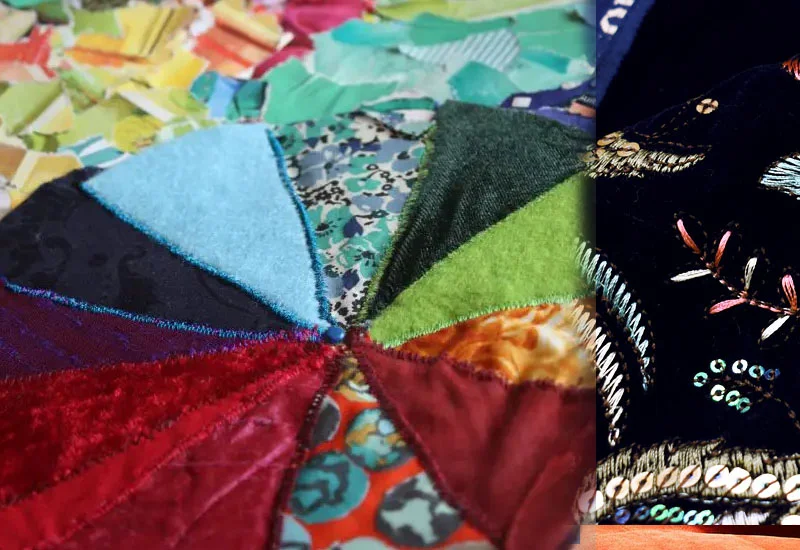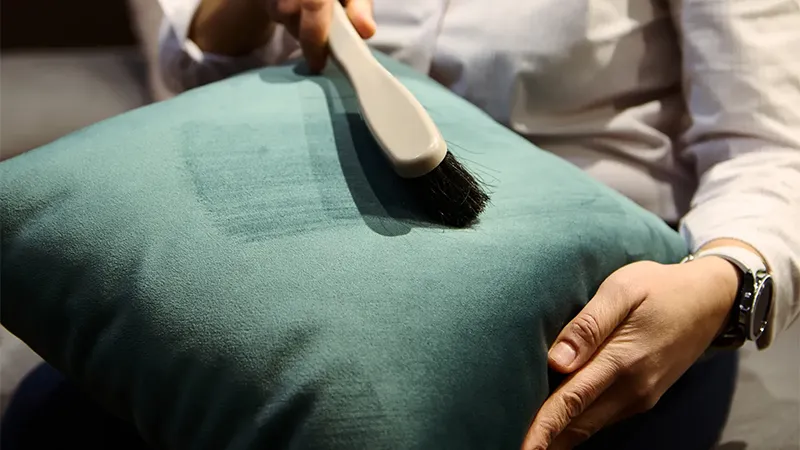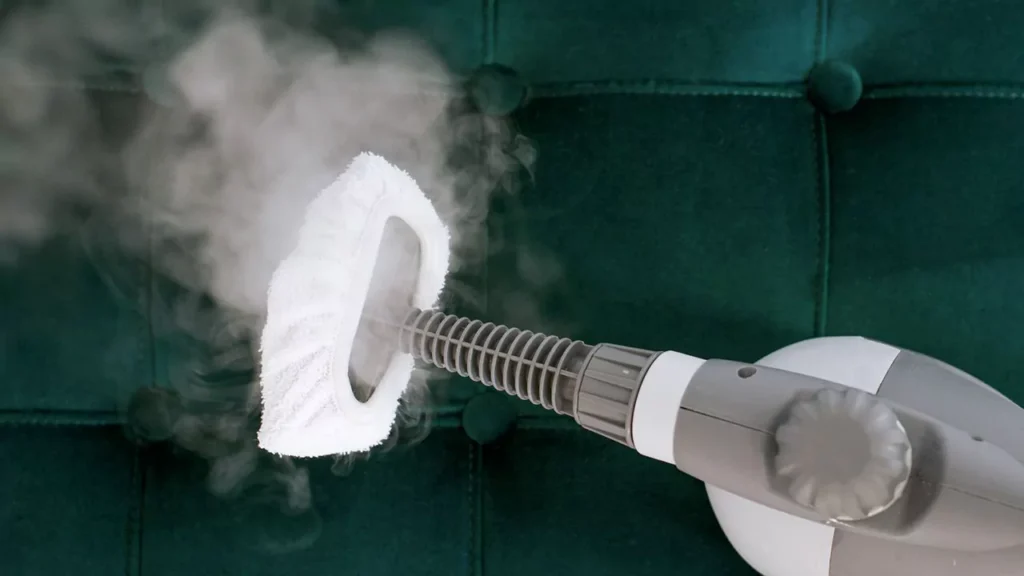The plush feel and classic good looks of velvet make it an opulent and classic fabric choice. However, like all fabrics, it requires proper care and maintenance to preserve its beauty.
Whatever the case may be—whether it’s an old velvet sofa that needs TLC or an heirloom velvet item that you inherited—you must know how to fix velvet fabric. Here you can find a detailed guide on restoring velvet to its original splendor.
Understanding Velvet Fabric

Before diving into the restoration process, it’s important to understand what makes velvet unique. Velvet is characterized by its dense pile, which is created by weaving two thicknesses of fabric together and then cutting them apart. This process results in a smooth, soft surface with a distinctive sheen. The pile can be made from various fibers, including silk, cotton, and synthetic materials.
Velvet is delicate and can be easily damaged by improper cleaning or handling. Its nap, or pile direction, can be disrupted, leading to a crushed or uneven appearance. Therefore, restoring velvet fabric requires careful attention and the right techniques.
Assessing the Condition of Your Velvet Fabric
The first step in restoring velvet fabric is to assess its current condition. Look for common issues such as:
- Crushed Pile: The velvet appears flattened or has lost its original texture.
- Stains: Spots or discoloration from spills, dirt, or other substances.
- Fading: Loss of color due to exposure to sunlight or other factors.
- Wear and Tear: Physical damage like rips, tears, or fraying.
Understanding the extent of the damage will help you determine the best course of action for restoration.
How to Restore Crushed Velvet Pile

One of the most common issues with velvet is a crushed pile. Here’s how to restore velvet fabric to its original plush state:
Steam Treatment
- Prepare the Area: Set up an ironing board and cover it with a clean, white cloth. Place the velvet item on top, ensuring it’s flat and smooth.
- Use a Steamer: Hold a handheld steamer about an inch away from the fabric. Move the steamer gently over the surface, allowing the steam to penetrate the fibers. Be careful not to let the steamer touch the fabric directly.
- Brush the Pile: While the fabric is still damp from the steam, use a soft brush to gently lift the pile. Brush in the direction of the nap to restore its texture.
- Allow to Dry: Let the fabric air dry completely. Avoid direct sunlight or heat sources, which can damage the fibers.
Professional Cleaning
If the crushed pile is severe, you might consider taking the item to a professional cleaner who specializes in velvet. They have the tools and expertise to handle delicate fabrics and can often achieve better results than home treatments.
Removing Stains from Velvet Fabric

Stains can be particularly challenging to remove from velvet due to its pile. Here’s a step-by-step guide on how to tackle common stains:
General Stain Removal
- Blot the Stain: As soon as a spill occurs, use a clean, white cloth to blot (not rub) the stain. This helps absorb excess liquid and prevents it from setting into the fabric.
- Prepare a Cleaning Solution: Mix a small amount of mild detergent with lukewarm water. Avoid harsh chemicals, which can damage the velvet fibers.
- Test in an Inconspicuous Area: Before applying the solution to the stain, test it on a hidden part of the fabric to ensure it doesn’t cause discoloration or damage.
- Apply the Solution: Dip a soft cloth into the cleaning solution and gently blot the stain. Work from the outside in to prevent the stain from spreading.
- Rinse and Dry: Use a clean, damp cloth to remove any soap residue. Blot the area with a dry cloth and let it air dry completely.
Oil-Based Stains
For oil-based stains like grease or makeup, you may need a different approach:
- Sprinkle Cornstarch: Apply a generous amount of cornstarch to the stain and let it sit for about 15 minutes. The cornstarch will absorb the oil.
- Brush Off: Gently brush off the cornstarch with a soft brush.
- Repeat if Necessary: If the stain persists, repeat the process or use a specialized velvet cleaner.
Addressing Velvet Fading and Discoloration
Velvet can fade over time, especially if exposed to sunlight. While it’s difficult to restore color to faded fabric, there are steps you can take to minimize further fading and improve its appearance.
Avoid Sunlight
Keep velvet items out of direct sunlight. Use curtains or blinds to protect furniture and other velvet pieces from UV rays.
Fabric Dye
For significant fading, you might consider using a fabric dye designed for velvet. This can be a complex process and may require professional assistance to ensure even color distribution.
Repairing Wear and Tear
Physical damage such as rips and tears can be repaired to extend the life of your velvet items.
Sewing Small Tears
For small tears, use a needle and thread that match the fabric color. Carefully stitch the tear closed, being mindful not to pull too tightly, which can cause puckering.
Patching Larger Areas
For larger areas of damage, you may need to patch the fabric. Cut a piece of matching velvet slightly larger than the damaged area and sew it in place using a hidden stitch.
How to Store Velvet Fabric

Proper storage is crucial to maintaining the integrity of velvet fabric. Here are some tips on how to store velvet fabric to prevent damage:
Clean Before Storing
Always clean velvet items before storing them. Any dirt or stains left on the fabric can become more difficult to remove over time.
Use Breathable Covers
Avoid plastic covers, which can trap moisture and lead to mold or mildew. Instead, use cotton or muslin covers to allow the fabric to breathe.
Store Flat or Roll
If possible, store velvet items flat to prevent creasing. For larger pieces like curtains, consider rolling them rather than folding to avoid creating permanent creases.
Avoid Heavy Items
Do not place heavy items on top of stored velvet fabric, as this can crush the pile and cause permanent damage.
How to Steam Velvet Furniture?

Velvet fabric features taller fibers on its surface, making it susceptible to compression over time. To maintain the beauty and cleanliness of velvet furniture, steaming is an effective solution.
Designers recommend using a steamer or the steam function on your iron to smooth out wrinkles. Gently brush against the direction of the fibers to help release any creases. Always set your steamer to low to prevent damaging the fabric. This method can effectively restore the soft texture and appearance of velvet.
Conclusion
Restoring velvet fabric requires patience and the right techniques, but the results are well worth the effort. By understanding how to restore velvet fabric, you can keep your treasured pieces looking beautiful for years to come.
Remember to also learn how to store velvet fabric properly to prevent future damage. Whether you choose to tackle the restoration yourself or seek help from a professional, taking care of your velvet fabric will ensure it remains a luxurious and elegant addition to your home.
For all your velvet needs, finding a reliable velvet fabric store is crucial. By following the tips above, you can locate a good velvet fabric store near me and access the materials and expertise needed to keep your velvet items in pristine condition.
